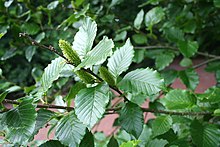Caucasian birch
| Caucasian birch | ||||||||||||
|---|---|---|---|---|---|---|---|---|---|---|---|---|

Caucasian birch ( Betula medwediewii ) in the arboreteum in Wageningen (Netherlands) |
||||||||||||
| Systematics | ||||||||||||
|
||||||||||||
| Scientific name | ||||||||||||
| Betula medwediewii | ||||||||||||
| rule |
The Caucasian birch ( Betula medwediewii ) is a large shrub of the genus birch in the birch family (Betulaceae). The distribution area is in Iran, Turkey and Georgia.
description
The Caucasian birch is an upright shrub up to 6 meters high , rarely a tree up to 20 meters high with a gray-yellow, rolling bark . The shoots are thick, stiff, and shiny light brown, and have large, green, and sticky buds. The leaves are broadly elliptical, 8 to 12 centimeters long, briefly pointed with a rounded or slightly heart-shaped base and an irregular double-serrated edge . The upper side of the leaf is deep green, the underside light green and hairy on the nerves. 8 to 11 severely sunken pairs of nerves are formed per leaf. The petiole is about 3 inches long, hairy, deeply rutted with large, permanent stipules . In autumn the leaves turn golden yellow. Upright, 3.5 centimeters long, cylindrical catkins are formed as female inflorescences . The middle lobes of the fruit scales are twice as long as the side lobes.
Distribution and ecology
The distribution area is in Iran, Georgia and Turkey. There it grows in species-poor forests on moderately dry to fresh, acidic to neutral, sandy soils in sunny locations. The species is frost hardy.
Systematics and research history
The Caucasian birch ( Betula medwediewii ) is a kind of the genus of birch ( Betula ) in the family of birch family (Betulaceae). It was first described in 1887 by Eduard August von Regel in the garden flora . Monthly magazine for German and Swiss gardening and floriculture . Edited by E. Regel . With the scientific name of the plant, Regel honored the discoverer of the species, the Russian botanist Jakob Sergejewitsch Medvedev (1847–1923). He had discovered the birch in July 1886 in Transcaucasia.
use
The species is used as an ornamental plant because of its wood but also because of its autumn color .
proof
literature
- Andreas Roloff , Andreas Bärtels: Flora of the woods. Purpose, properties and use. With a winter key from Bernd Schulz. 3rd, corrected edition. Eugen Ulmer, Stuttgart (Hohenheim) 2008, ISBN 978-3-8001-5614-6 , p. 140.
Individual evidence
- ↑ German name after Roloff et al .: Flora der Gehölze , p. 140
- ↑ a b c Roloff et al .: Flora of the Woods , p. 140
- ↑ a b Betula medwediewii. In: Germplasm Resources Information Network (GRIN). United States Department of Agriculture, accessed December 28, 2011 .
- ↑ Walter Erhardt among others: The great pikeperch. Encyclopedia of Plant Names . Volume 2, page 1996. Verlag Eugen Ulmer, Stuttgart 2008. ISBN 978-3-8001-5406-7

